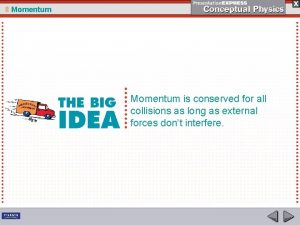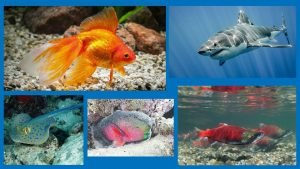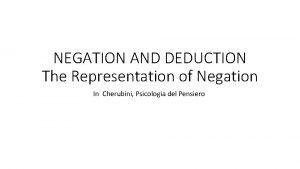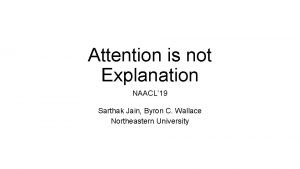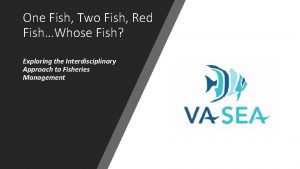To Fish or Not to Fish Opportunities and














- Slides: 14

To Fish or Not to Fish - Opportunities and Constraints to Youth Involvement in Small Scale Capture Fisheries and Aquaculture Indika Arulingam, Likimyelesh Nigussie, Sonali Senaratna Sellamuttu, Liza Debevec, Palal Moet, Sanjiv De Silva

Overview 1. Largely desk-based study on Opportunities and Constraints to Youth Involvement in small-scale fisheries (SSF), aquaculture and value chains 2. Follow-up field study on interactions between the SSF sector, household livelihoods strategies, and livelihood aspirations and outcomes for youth from SSF in Kyonkadun Village, Ayerarwady Delta, Myanmar

Introduction • The population of those from ages 15 -24 expected to reach 1. 3 billion by 2050 (FAO et al. 2014) • Unemployment rates high among youth, when compared to adult populations (ADB, 2017) • Widely believed that youth are leaving behind livelihoods in agriculture, for other options (White, 2012)

Study on Opportunities and Constraints to Youth Involvement in small-scale fisheries (SSF), aquaculture and value chains Objective: To take stock of the current status in relation to the engagement of youth in small scale fisheries and aquaculture and value chains in 8 FISH focal countries in Africa and the Asia-Pacific Methodology • Review of peer-reviewed and gray literature: 98 publications • Key Informant Interviews: 20 interviews

Findings • Youth as a social category is highly contextual defined not only by age but also gender, education, marital status, engagement with the labour market, and other factors (Pyburn et al. 2015) • Youth involvement in aquaculture, small scale fisheries and value chains is under-studied (FAO, 2016) • From what is known, for most youth, the fisheries sector is not the first choice of employment. (KIIs)

Key Constraints: • Limited access to land, finances, other resources, decision-making, knowledge and know-how. Further amplified in the case of young women (Adesugba and Mavrotas, 2016; FAO, 2014) • Physical labour, low pay, low social status. In certain cases, discrimination and harassment (Nuruzzaman et al. 2014; Bene and Merten, 2008 ) • Ecosystems with (Venkatachalam et al. 2010) diminishing productivity

Key Opportunities • Employment and entrepreneurship opportunities in the fast growing aquaculture sector (Hishamunda et al. 2014) • Moving down the value chain beyond primary production might hold potential (KIIs) • Opportunities with increased integration of ICT technologies (still to be tested) (KIIs)

Four pathways for a more youth-inclusive program under FISH • Understanding the impact of economic, political and social shifts at globalnational-local levels on youth involvement in aquaculture and small-scale fisheries. • Analysis of the policy architecture that impact youth involvement in aquaculture in small-scale fisheries. • Understanding youth aspirations and perceptions of aquaculture and smallscale fisheries. • Building a youth-oriented approach to aquaculture and small-scale fisheries.

Follow up Field-based Study 1. What is the (changing) role of SSF in the livelihood aspirations and strategies adopted by the households in the village? 2. What are the livelihood aspirations and livelihood outcomes (and role of SSF in these) for youth from households that adopt SSF as a livelihood strategy? 3. What are the impacts of the above on SSF in the village?

Follow up Field-based Study Site: Kyonkadun Village in the Ayeyarwady Delta of Myanmar Methodology: • Over the course of 12 months (2019), reconnaissance visit in November, 2018 • Literature review of the political economy of the fisheries sector in Myanmar • Data collection and analysis through mapping exercises, focus group discussions, a household survey, in-depth interviews and photo-stories

Preliminary Findings from the literature review and KIIs SSF is often the last choice of employment for youth Access to resources and decision making constrained by gerontocratic systems for youth There is a trend of youth migration out of agriculture. Little is known about youth migration and SSF (particularly for the Asia-Pacific and Africa) Preliminary findings from the field study SSF appears to be an ageing population Decision making on fishing licenses potentially dominated by older men from better-off socio -economic backgrounds, with little space for (SSF) youth involvement Youth migration from SSF appears to be higher when compared to other (including agricultural) households Youth migration from SSF households more gendered with different opportunities and constraints for female and male youth

International Water Management Institute: http: //www. iwmi. cgiar. org/ World. Fish: https: //www. worldfishcenter. org/ FISH CRP: https: //fish. cgiar. org/

Thank You

We would like to acknowledge all CGIAR Research Programs and Centers for supporting the participation of their gender scientists to the Seeds of Change conference. Photo: Neil Palmer/IWMI gender. cgiar. org
 One fish two fish red fish blue fish ride
One fish two fish red fish blue fish ride One fish two fish blowfish blue fish
One fish two fish blowfish blue fish Scale types fish
Scale types fish Sadlier vocabulary workshop level d unit 1
Sadlier vocabulary workshop level d unit 1 A big fish swims up and swallows a small fish at rest
A big fish swims up and swallows a small fish at rest Cartilaginous fish vs bony fish
Cartilaginous fish vs bony fish Cartilaginous fish features
Cartilaginous fish features Whole fish market form
Whole fish market form Being too broad
Being too broad The opportunities of media and information
The opportunities of media and information A whale is not a fish negation
A whale is not a fish negation If you are not confused you're not paying attention
If you are not confused you're not paying attention Not dressy
Not dressy Attention is not not explanation
Attention is not not explanation P
P




